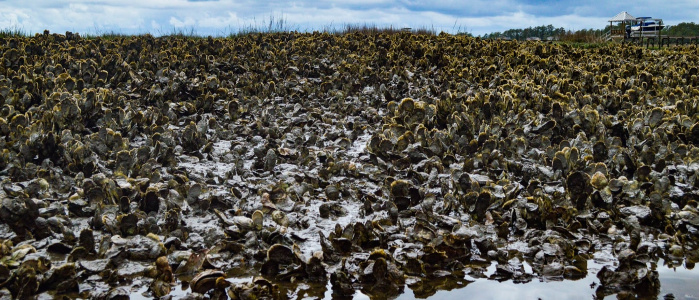Oysters are no ordinary animal, and their recycled shells are no exception. These guys perform amazing filtration for our local waters, provide vital habitat for marine life and protect our lands from the changing tides. Plus, they’re delicious to dine on! Let’s dive a little deeper into the amazing power of oysters, shall we?As oysters grow (whether on natural reefs or artificial ones made of bagged, recycled oyster shell), they begin to filter the waters around them. A single oyster can typically filter up to 50 gallons of water per day; imagine what entire populations are accomplishing to keep our waterways clean!Thanks to oysters, the saltmarsh is one of the most biodiverse habitats in the world, second only to the rainforest. Wild oysters form together in clusters and serve as a haven for over 130 species of marine life. In due time, these animals then become a valuable food source for other animals higher up in the food chain.Oysters also serve as the first line of defense against the changing tides. They help stabilize the shoreline by serving as a natural breakwater and holding the pungent pluff mud in place. This pluff mud allows the second line of natural defense to root, the saltmarsh cordgrass.Lastly, oysters are a cultural cuisine in the Lowcountry. Because of their role with water filtration, they tend to take on the flavor of the environment around them. It’s not unusual to hear oysters described as briny, buttery, salty or sweet. Do you have a flavor profile you prefer? Test out your taste buds the next time you dine on one of these delicious bivalves!How can you support healthy oyster populations?Choose Local – Our waters are teeming with oysters that are taken care of responsibly. Local is best when it comes to your seafood. When you’re dining out, ask what local oysters are available for order.Eat What’s in Season – Spoiler alert: Oysters are in season every season, it’s just a matter of what type you’re trying out. Wild oyster clusters are in season typically in months that include an “r”. In the summertime, look out for the farmed single oysters. If you see Sea Clouds, Toogoodoozies, Lowcountry Cups, Perky Sea Cups and Mosquito Fleet Petites on menus near you, know you’re supporting our local oyster farmers!Recycle Your Shells – Have you heard of artificial oyster reefs? These are comprised of bags of recycled oyster shells placed strategically in locations facing erosion. These bags help provide a hard substrate for baby oysters, called spat, to latch onto and grow. The South Carolina Oyster Restoration and Enhancement Program (SCORE), needs your help in recycling your shells! Find recycling centers at score.dnr.sc.gov.Assist in an Oyster Reef Build – Want to help the oyster populations full-circle? After eating local and recycling, sign up for a reef build with the South Carolina Department of Natural Resources (SCDNR). Learn more at dnr.sc.gov.Symbolically Adopt an Oyster Bag – This summer, the Aquarium is partnering with the South Carolina Department of Natural Resources to rebuild our oyster shell reef. Support our conservation work by adopting an oyster bag at
donate.scaquarium.org/oyster-bag-adopt.
All About Oysters
Mar
09
Blog Categories
- At the Aquarium
- Community
- Conservation
- Education
- Miscellaneous
- Our Members
- Research
- Sea Turtle Care Center
- 2007 Released – Turtle Patient Boards
- 2008 Released – Turtle Patient Boards
- 2009 Released – Turtle Patient Boards
- 2010 Released – Turtle Patient Boards
- 2011 Released – Turtle Patient Boards
- 2013 Released – Turtle Patient Boards
- 2017 Released – Turtle Patient Boards
- 2018 Released – Turtle Patient Boards
- 2019 Released – Turtle Patient Boards
- 2020 Released – Turtle Patient Boards
- 2021 Released – Turtle Patient Boards
- 2022 Released – Turtle Patient Boards
- 2023 Released – Turtle Patient Boards
- 2024 Released – Turtle Patient Boards
- Basement Tank – Turtle Patient Boards
- Tank 1 – Turtle Patient Boards
- Tank 2 – Turtle Patient Boards
- Tank 4 – Turtle Patient Boards
- Tank 5 – Turtle Patient Boards
- Tank 7 – Turtle Patient Boards
- Sea Turtle Rescue Program
- Turtle Patient Boards
- Uncategorized


